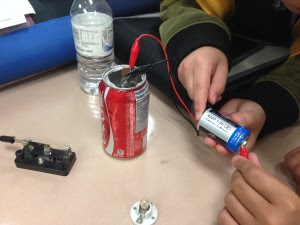by Erin Quinn.
Our kids have gotten down and dirty with prototyping and design thinking over the past few weeks, and now it was time for them to show what they’ve accomplished. So today, we had a celebration of learning where the students showed their models and talked about their idea.
I was so impressed by the students today. Here’s why this interdisciplinary project and design thinking helped them do something pretty incredible:
- Having a problem that could be viewed through many different lenses (the CTF occupation areas) allowed for multiple entry points, and let students choose a topic that truly interested them.
 |
| Multiple topics mean every student can personalize his or her own learning. |
- Students had to learn about their career cluster prior to the moon disaster, and figure out how the science of the moon would affect their topic. Their research was purposeful and they realized its importance because their solution depended on it. We had a short period devoted to research right at the beginning, but most research happened spontaneously throughout because kids had questions that needed answering.
 |
| These students had to learn about how batteries work and energy is transferred to design this solution to the problem of not having power. |
- Each occupational area had countless possibilities within it. Students could use what they knew about the science of the moon and planet earth, as well as their idea generation they did at the beginning of the prototyping process, to allow them to find a solution that made sense to them. Because of this, a high number of students were able to speak confidently and accurately about how their solution worked. Most students were also able to explain the science behind their topic, too.
 |
The students who designed this house could explain exactly how it would withstand earthquakes and tsunamis. |
- They’re doing important work. Though the scenario is a bit farfetched (let’s hope a meteor doesn’t hit the moon!), the problems they tackled are very real. These thirteen year olds were coming up with sophisticated solutions to problems like natural disasters, nonrenewable resources, sustainability, and community engagement. The future is in good hands with these kids.
 |
| Sustainable agriculture, geopowered air filtration, and making dirty water clean (notice the PH strips – they managed to their their filtered water to be PH neutral!) |
- They could choose if they wanted to go high tech or low tech. Because of the loan from ILT of the Maker Kit, options were available to students who wanted to try some cool technologies like Arduinos, Little Bits, and robotics. But if kids wanted to use good old Lego? That was available too. And cardboard was a popular building supply, too.
 |
| Lego Mindstorm Robots and Lego Building Blocks. |
- Kids tried things they had never done before and learned something in the process.
 |
| A boy learning how to sew. |
- Lots of things didn’t work. That is part of the design process. Failure is a huge part of it. And learning to be okay with failure – to use it as information for what the next steps should be – was an important lesson many of these students learned. I had a conversation with a group who tried to make a generator, but whatever they tried, it still didn’t work. But they were able to explain exactly why it should work, even though it didn’t. They tried different prototypes and adjusted, and researched, and adjusted, but it still didn’t work. And that was okay.
 |
| These boys were trying to find a way to store energy. They tried a pop can, a battery, and acid. Here’s how they explained it to me: Student 1: “We used the solution in the can because it has a PH level of 12.” Student 2: “And because it has electrolytes.” Student 1: “And electrolytes conduct. And this is zinc, and this is copper [gesturing to the metal plates in the acid solution]. And there’s an aluminum can that is also conductive. And we’re hoping that this will store energy.”It didn’t. But knowing the PH and conductivity of different solutions and materials and being able to hypothesize that it might work to store energy is a pretty incredible thing for students in grade 7 to understand. |
We’re not quite done this project yet. Because all grade 7 students worked on this project, there were three groups in each occupation area. On Friday, Monday, and Tuesday, groups are going to give a final pitch, with the goal of convincing their peers that their solution in the occupation area was the best one. They have created persuasive advertisements and will be giving a two-minute persuasive speech over a video broadcast that will be livestreamed to all the grade 7 classrooms. This part of the project let us more fully integrate Language Arts into this project.







 Erin Quinn
Erin Quinn









Be First to Post Comment !
Post a Comment